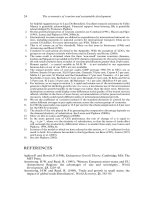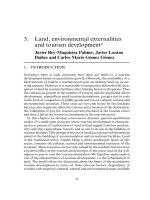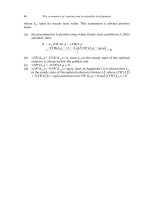THE ECONOMICS OF MONEY,BANKING, AND FINANCIAL MARKETS 555
Bạn đang xem bản rút gọn của tài liệu. Xem và tải ngay bản đầy đủ của tài liệu tại đây (36.01 KB, 1 trang )
CHAPTER 20
The International Financial System
523
are greater than imports as in 2007 by $28.8 billion, we have a trade surplus; if
imports are greater than exports, we have a trade deficit.
Additional items included in the current account are the net receipts (cash
flows received from abroad minus cash flows sent abroad) from three categories: investment income, service transactions, and unilateral transfers (gifts,
pensions, and foreign aid). In 2007, for example, net investment income was
minus $14.2 billion for Canada because Canadians received less investment
income from abroad than they paid out. Since Canadians made more unilateral
transfers to foreign countries than foreigners made to Canada, net unilateral
transfers were minus $1 billion. The sum of the previous two items plus the
trade balance is the current account balance, which in 2007 showed a surplus
of $13.6 billion.
Another important item in the balance of payments is the capital account,
the net receipts from capital transactions. In 2007 the capital account was
$4.2 billion, indicating that $4.2 billion more capital came into Canada than left
Canada. Another way of saying this is that Canada had a net capital inflow
of $4.2 billion.4 The sum of the current account and the capital account equals
the official reserve transactions balance, which was $21.9 billion in 2007.
When economists refer to a surplus or deficit in the balance of payments, they
actually mean a surplus or deficit in the official reserve transactions balance.
Because the balance of payments must balance, the official reserve transactions
balance, which equals the current account plus the capital account, tells us the net
amount of international reserves that must move between governments (as represented by their central banks) to finance international transactions. The relationship between the current account, the capital account, and the change in net
government international reserves can thus be expressed as:
Current account * capital account + net change in government international
reserves
This equation shows us why the current account receives so much attention
from economists and the media. The current account balance tells us whether
Canada (private sector and government combined) is increasing or decreasing
its claims on foreign wealth. A surplus indicates that Canada is increasing its
claims on foreign wealth, and thus is increasing its holdings of foreign assets
(both good things for Canadians), and a deficit indicates that Canada is reducing
its holdings of foreign assets and foreign countries are increasing their claims on
Canada.5
For example, the rapid growth in the U.S. current account deficit in recent years,
which is nearing US$1 trillion, has raised serious concerns that these large deficits
may have negative consequences for the U.S. economy (see the Global box, Why
the Large U.S. Current Account Deficit Worries Economists).
4
Note that the capital account balance number reported above includes a statistical discrepancy item
that represents errors due to unrecorded transactions involving smuggling and other capital flows
($4.1 billion in 2007). Many experts believe that the statistical discrepancy item, which keeps the balance of payments in balance, is primarily the result of large hidden capital flows, and this is why it is
included in the capital account balance reported above.
5
The current account balance can also be viewed as showing by how much total saving exceeds private sector and government investment in Canada. We can see this by noting that total Canadian saving equals the increase in total wealth held by the Canadian private sector and government. Total
investment equals the increase in the Canadian capital stock (wealth physically in Canada). The difference between them is the increase in Canadian claims on foreign wealth.









